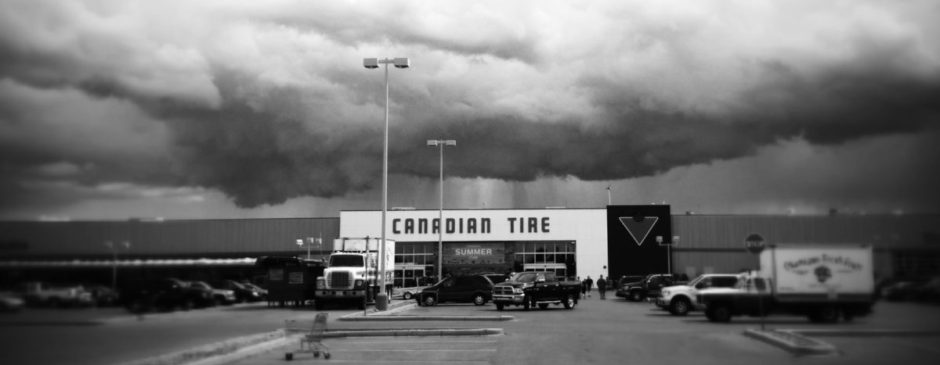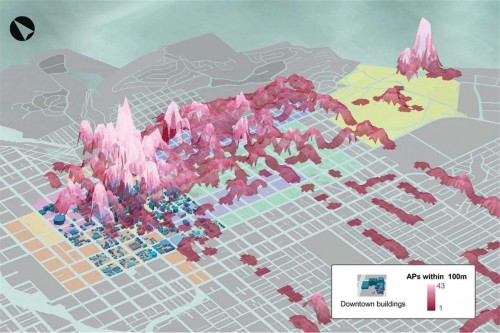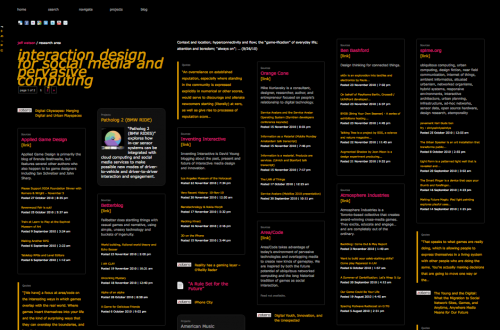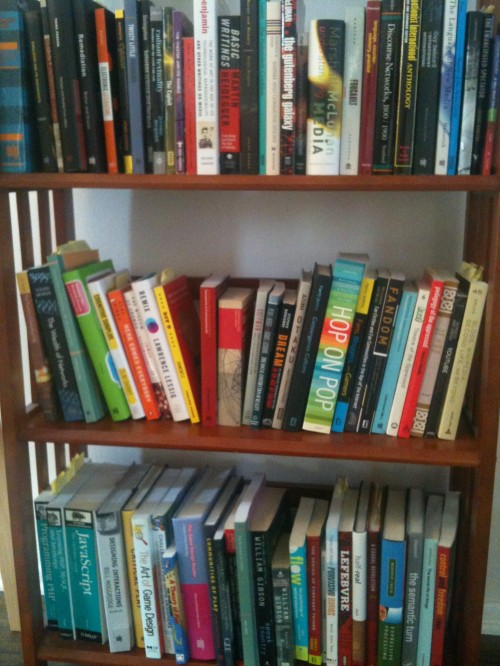This post is a part of a series covering my qualifying exam research areas. Scroll to the bottom of this post for links to each area, or click here for a general description of the process.
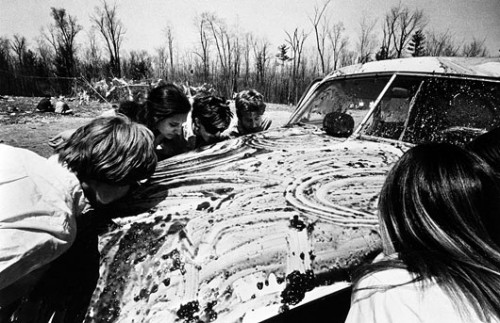
Description
The increasingly “device agnostic” Web constitutes a vast and rapidly evolving multi-modal metaplatform for collaboration, performance, and community-building. The radical reconfiguration of spatial, institutional, and social boundaries that has accompanied and guided the emergence of network technology and social media has brought with it an irreversible decentralization of the production and dissemination of knowledge and culture (Benkler, Von Hippel). The effects of these shifts are only beginning to be felt, with policy makers, educators, cultural theorists, and corporations scrambling to adjust to/capitalize on a broad class of new participatory media practices. But while the breadth and scope of media participation have been vastly increased by the core affordances of new media objects and the dawning ubiquity of network technologies, the defining practices of participatory culture have been with us since long before the birth of YouTube and Web 2.0 (Jenkins). From the amateur operators of the early days of radio (Douglas), to the feminist “vidding” subcultures of the 1970s and 80s (Coppa), our engagement with media has always been just that: engagement, and not pure consumption. Until recently, personal and academic uses of popular culture artifacts — remixing, fan fiction, filesharing — have been largely invisible to the corporate apparatus underwriting their original production; but as amateur creators and remixers have flooded to the Web to share and discuss their works, hitherto “private” practices have become public, much to the chagrin of those with a vested interest in upholding the kinds of scarcity and centralized authority required for the maintenance of the status quo (Lessig).
The present moment is a crucial one in this regard. A failure by policy makers to imaginatively engage with the affordances of the Web could restrict or roll back the transformative potentials promised by the advocates of openness, transparency, and collective intelligence (Levy, O’Reilly). To steer clear of this kind of disaster, it falls to the makers of media — from on- and offline amateurs to corporate department heads — to identify the ways in which new arrangements of cultural authority and economic power, particularly in the realms of intellectual property and knowledge production, might emerge in the context of distributed and procedural authorship. Toward this end, it is essential to develop an understanding of the motivations, pleasures, requirements, effects, and potentials of participation across a variety of domains.
Three closely-related fields of study inform this understanding. Readings from Fan Studies provide insights into the role of participatory culture in the articulation of identity and resistance, with particular focus on the ways in which fans and producers negotiate, co-create, and contest meanings within the hybrid spaces of canon and taste (Coppa, Fiske, Jenkins). Seminal ethnographic and critical perspectives from cultural studies and social science (De Certeau, Foucault, Goffman) extend these insights beyond fandom and into broader conversations concerning performativity and the uncertain ontological status of the author/viewer divide. Within this context, investigations of the shifting logics of cultural production, circulation, and reputation help to establish frameworks for understanding how new technologies — from amateur printing presses to Web 2.0 — can disrupt existing legal and industrial structures as they give rise to new modes of engagement (Benkler, Berners-Lee, Bruns, Douglas, Green, McPherson, Lessig). Finally, a traversal of the history of avant-garde participatory art practice reveals a range of theories, aesthetic systems, and process-oriented artworks whose legacy constitutes a deep and wide working-through of the myriad theoretical and practical challenges facing contemporary media makers invested in notions of the participatory (Bishop, Boal, Bourriaud, Kaprow, Knabb, Kester, O’Donnell, Ranciere).
Bibliography
Anderson, Steve. “Aporias of the Digital Avant Garde,” Digital Humanities Quarterly, Summer, 2007. http://digitalhumanities.org/dhq/vol/1/2/000011/000011.html
Baym, Nancy K. and Burnett, Robert. “Amateur Experts: International Fan Labor in Swedish Independent Music,” International Journal of Cultural Studies, 12(5): 1-17.
Benkler, Yochai. The wealth of networks : how social production transforms markets and freedom. Yale University Press, 2007.
Berners-Lee, Tim. “Long Live the Web: A Call for Continued Open Standards and Neutrality.” Scientific American. December, 2010.
Bishop, Claire. Participation. The MIT Press, 2006.
Boal, Augusto. Theatre of the Oppressed. Pluto Press, 2008.
Bourriaud, Nicolas. Relational Aesthetics. Les Presse du Reel, 1998.
boyd, danah. “Identity Production in a Networked Culture: Why Youth Heart MySpace.” American Association for the Advancement of Science, 2006.
Bruns, Axel. Blogs, Wikipedia, Second Life, and Beyond: From Production to Produsage. Peter Lang Publishing, 2008.
Coppa, Francesca. “Women, ‘Star Trek’ and the Early Development of Fannish Vidding,” Transformative Works and Cultures 1, 2008.
Darnton, Robert. “Readers Respond to Rousseau: The Fabrication of Romantic Sensibility,” The Great Cat Massacre And Other Episodes in French Cultural History. Basic Books, 2009.
Dena, Christy. “Emerging Participatory Culture Practices: Player-Created Tiers in Alternate Reality Games,” Convergence, February 2008. 41-58.
Diamond, Sara. “Participation, Flow, and the Redistribution of Authorship: The Challenges of Collaborative Exchange and New Media Curatorial Practice,” Museums and the Web. Banff Institute, 2005.
Douglas, Susan J. “Popular Culture and Populist Technology: The Amateur Operators, 1906-1912,” Inventing American Broadcasting, 1899-1922. Johns Hopkins University Press, 1989.
Fiske, John. “The Cultural Economy of Fandom,” in Lewis, Lisa A. (ed.) The Adoring Audience: Fan Culture and Popular Media. Routledge, 1992.
Foucault, Michel. “What is an Author?” in Lodge, D. (ed) Modern Criticism and Theory: A Reader. Longman, 1988.
Galloway, Alexander and Thacker, Eugene. The Exploit. University of Minnesota Press, 2007.
Goffman, Erving. The Presentation of Self in Everyday Life. Anchor Books, 1959.
Green, Joshua and Burgess, Jean. YouTube: Online Video and Participatory Culture. Polity, 2009.
Higgins, Dick. “Dick Higgins on Intermedia,” Something Else Newsletter #1. Something Else Press, 1965. http://www.ubu.com/papers/higgins_intermedia.html
Jenkins, Henry, Puroshotma, Ravi, Clinton, Katherine, Weigel, Margaret & Robison, Alice J. (2005). Confronting the Challenges of Participatory Culture: Media Education for the 21st Century, available at http://www.newmedialiteracies.org/files/working/NMLWhitePaper.pdf. Retrieved on 1/22/2009.
______. “Nine Propositions Towards a Theory of YouTube,” Confessions of an Aca-Fan, 2006.
______. Fans, Bloggers, and Gamers: Media Consumers in a Digital Age. NYU Press, 2006.
Kaprow, Allan. “’Happenings’ in the New York Scene,” in Wardrip-Fruin, Noah and Montfort, Nick (ed.) The New Media Reader. MIT Press, 2003.
Kester, Grant. Conversation Pieces. University of California Press, 2004.
Lessig, Lawrence. Remix: Making Art and Commerce Thrive in the Hybrid Economy. Penguin Press HC, The, 2008.
McGonigal, Jane. “Why I Love Bees: A Case Study in Collective Intelligence Gaming,” Ecologies of Play. Ed. Katie Salen. MIT Press, 2008. 199-228. http://www.mitpressjournals.org/doi/pdfplus/10.1162/dmal.9780262693646.199
McPherson, Tara, ed. Digital Youth, Innovation, and the Unexpected. MIT Press, 2007.
O’Donnell, Darren. Social Acupuncture. Coach House, 2006.
Ranciere, Jacques. The Emancipated Spectator. Verso, 2009.
Qualifying Exam Areas
- New media spaces [blog archive]
- History and theories of participatory culture and art practice [blog archive]
- Interaction design for social media and pervasive computing [blog archive]
I’ve also written a brief post on the ongoing role that this website is playing in my research:
Finally, you can download the latest version of my exam area descriptions and bibliographies in .pdf form here.
